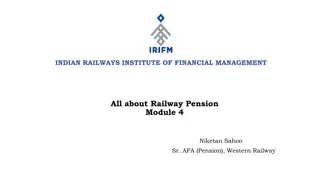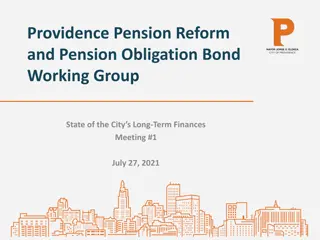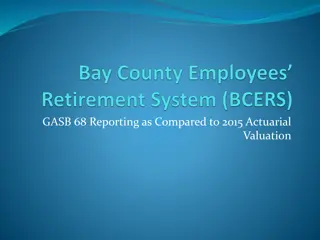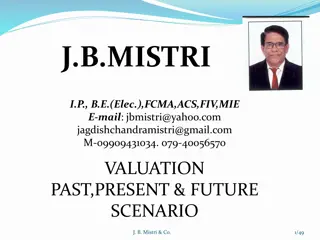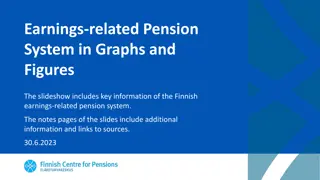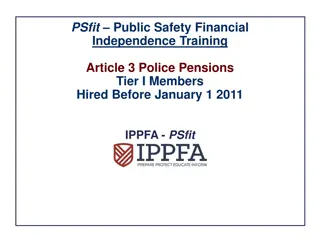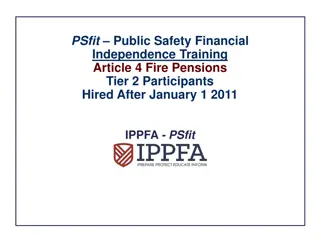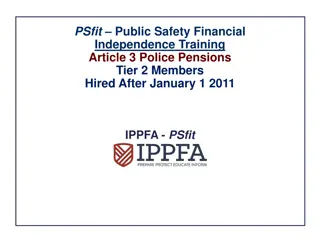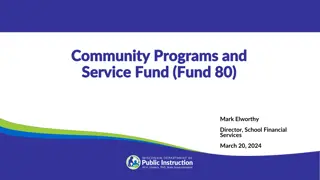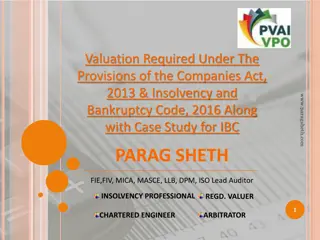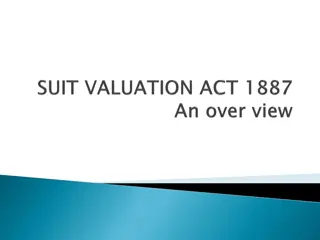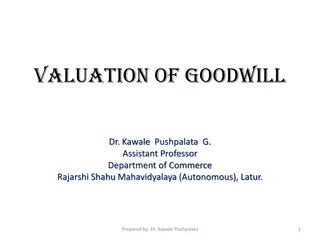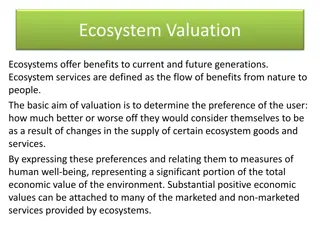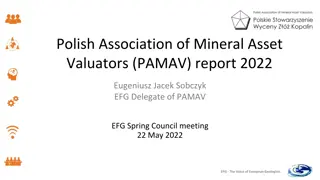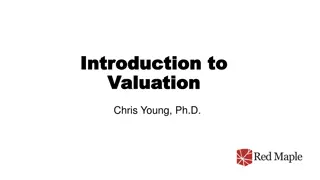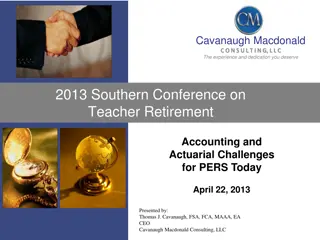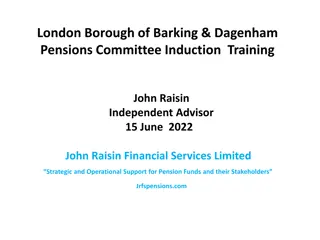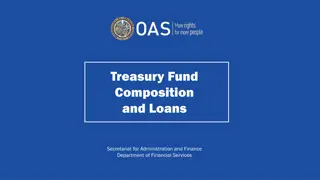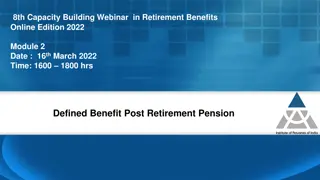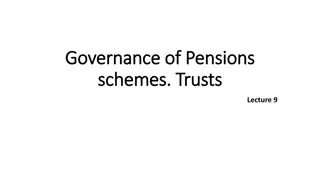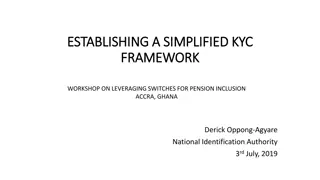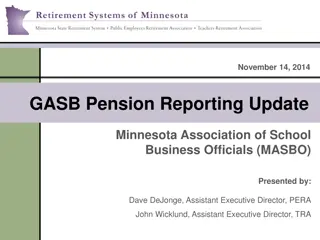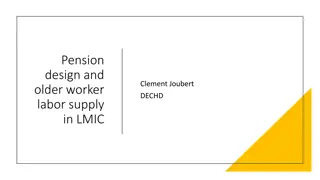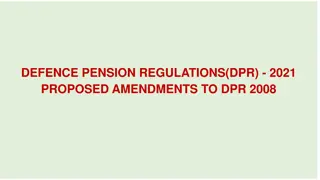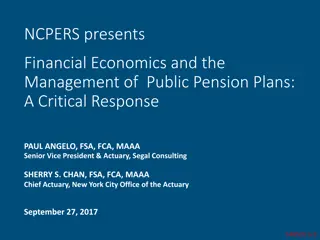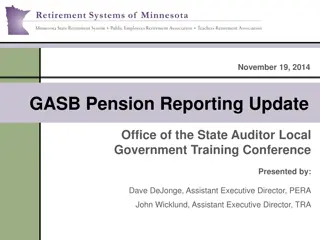Northamptonshire Pension Fund 2013 Valuation Overview
The Northamptonshire Pension Fund 2013 Valuation Report discusses the implications for Academy employers, focusing on aspects like the triennial valuation, covenant, risks, DCLG/DfE guidance, and annual accounts. The report provides insights into the pensions landscape, fund details, and the valuation process timeline, highlighting the importance of accurate data submission. Key topics include investment returns, contributions, administering authority responsibilities, and employer rates. Questions are encouraged throughout the discussion.
Uploaded on Sep 17, 2024 | 0 Views
Download Presentation

Please find below an Image/Link to download the presentation.
The content on the website is provided AS IS for your information and personal use only. It may not be sold, licensed, or shared on other websites without obtaining consent from the author. Download presentation by click this link. If you encounter any issues during the download, it is possible that the publisher has removed the file from their server.
E N D
Presentation Transcript
Northamptonshire Pension Fund 2013 Valuation Implications for Academy employers Douglas Green FFA 1 July 2013 Hymans Robertson LLP and Hymans Robertson Financial Services LLP are authorised and regulated by the Financial Services Authority
What we will be talking about today 1. What the triennial valuation does 2. How the results will impact you Douglas Green 3. Covenant and risks 4. DCLG/DfE guidance (pooling etc) 5. Annual accounts (FRS17) Ask questions as we go along! 2
The pensions landscape N.B. LGPS reform N.B. Government pensions reform (other Regulations) LGPS Regulations Civil Service Scheme LGPS NHS Scheme Teachers Scheme Fund Fund Fund .... unfunded 4
The Fund in summary (Benefits to local economy too) a) Investment returns Pension Fund Benefits to members and dependants (as per LGPS Regulations) b) Member contributions c) Employer contributions a) Determined by investment strategy and manager performance b) Determined by LGPS Regulations c) Must meet balance of cost over longer term: valuation calculation 5
The valuation overall Administering Authority Provide advice & formal report Regular communication Funding Strategy Statement Actuary Employers Rates & Adjustment Certificate (2014-17) Statutory requirement every 3 years 6
Valuation timetable March 2013 December 2013 March 2014 New Rates Payable Q1 2014 Q2 2013 Q3 2013 Q4 2013 Q1 2013 Preparation for valuation Data for actuary Actuary does his sums Valuation results Consultation on FSS Finalise employer contributions 7
Data submission for the 2013 Valuation Rely on accuracy of membership data Administering Authority require information from employers Changes in membership Correct salaries/contributions paid Missing/incorrect data could result in: A higher value being placed on future benefit promises A higher contribution rate Additional fees for you 8
Setting your contribution rate Education Employers Administering Authority (Pension Board) Calculate next 3 years contribution rates Education provision Members Affordability (to be balanced with) Prudence 9
2013 valuation: what employers need to do 1. Liaise with pensions team 2. Data correct and up to date * 3. Watch out for communications 4. Look out for Funding Strategy Statement (FSS) consultation * Data is for life, not just for valuations 10
Calculating Employer contributions (Benefits to local economy too) a) Investment returns Employer sub-fund individually tracked b) Member contributions Benefits to members and dependants (as per LGPS Regulations) c) Employer contributions a) Pro-rata Fund returns b) Paid by Employer s employees only c) Employer must meet balance of its own obligations 12
Liabilities calculated per member Financial assumptions: Pay growth to retirement Lump Sum Member s pension (paid for life, annual increases) Increases to pensions in deferment Increases to pensions in payment Also: Investment returns (see next slide) Dependant s pensions Commutation levels Life expectancy Proportions married etc Demographic assumptions: 13
Combine with asset value and return assumption Lump Sum Investment returns Member s pension (paid for life, annual increases) Contributions Investment returns Dependant s pensions Current assets Now Retirement 14
What has happened since 2010? X Good asset returns Reduced real yields (therefore reduced expected returns) Reduced inflation BUT Lower salary expectations Longer life expectancies Variable impact of new LGPS New LGPS See next few slides 15
Market movements 2010 to 2013 Liability growth out-stripped asset growth 16
Why does this matter? Lower life expectancies => lower liabilities => lower contributions Employer A Higher life expectancies => higher liabilities => higher contributions Employer B The Fund seeks to be fair to all employers 18
New scheme cost differs between employers New scheme costs more Average saving -1.5% New scheme saves money Employers Winners and losers 19
Outlook for 2013 Compared against 2010 valuation: Funding levels likely to be lower Deficits likely to be bigger (Theoretical) contribution rates likely to be higher Consider contributions split % of pay and Results will vary significantly between employers Actuary helps Fund to work with you 20
What do we want to achieve? a) Probability of reaching target set suitably above 50% b) Reach target over agreed period c) Recognising differences between types of Fund employers Other employers Academies Consistent, not necessarily the same Ceding Councils 21
Assessing employer covenant Issues What is chance of employer leaving Fund? What is risk to Fund if employer leaves? Employer risk Tax-raising powers? Type of body (Scheduled vs Admitted Body) Open or closed to new entrants Guarantor in place? Funding position/size of liabilities Financial strength (ie ability to meet liabilities) 23
Employer information for Fund register Challenge: protect the Fund, consistency* between employers, avoid pushing employers into insolvency. (* consistency is not necessarily the same result ) Fund needs to understand the risks More complete & positive information = stronger covenant = longer term view can be taken in which case consider stabilising contributions? 24
Employer contributions: in practice We know markets won t follow our assumptions We know markets vary from year to year So instead of calculating the contribution rate..... .....we might project chosen contribution patterns and measure the probability of achieving full funding over a given (long) period Normally only available to Councils Underpay in bad times, overpay in better times 25
Stabilisation? e.g. chosen contributions might be ceding Council rates or chosen contributions might be higher than ceding Council rates In both cases: probability of full funding? risk of deficit? risk vs size of deficit? 26
Example output: success vs risk 150% 140% Funding level (gilts +1.6% basis) (+/-0.5% of pay) 130% Median outcome c120% 120% 110% 100% 90% 80% 70% 60% 1 in 20 chance FL = 40% 50% 40% 30% 20% 10% significant downside risk 0% 2016 2031 2012 2013 2014 2015 2017 2018 2019 2020 2021 2022 2023 2024 2025 2026 2027 2028 2029 2030 2032 2033 2034 100% on gilts +1.6% basis Vary the chosen contributions: consider the risks 27
Q: Why might Academies need higher annual increases? A: Because ceding Council keeps ex-employees liabilities and assets (don t transfer to Academy) Council Academy (say 10% of Council actives) Deficit = 20 Actives 40 20 Deferreds 20 20 Deficit = 2 4 Pensioners 2 40 40 Liabilities Assets Liabilities Assets Payroll: 20 2 28
Ceding Council retains potential rewards Say assets grow 10% (expected to outperform liabilities) Council Academy (say 10% of Council actives) Deficit = 12 Actives 40 28 Deficit = 1.8 4 Deferreds 20 20 2.2 Pensioners 40 40 Council deficit = 12 = 60% (% of payroll) 20 Liabilities Assets Academy deficit = 1.8 = 90% (% of payroll) 2 So asset outperformance aids Council s deficit recovery 29
but also retains potential risks Q: Academy initial asset allocation method wrong ? A: No, Councils retain risks, as well as rewards, in respect of ex-employees e.g. Say assets fall 10% Council deficit = 100 liabilities less 72 assets = 28, which is 140% of payroll Academy deficit = 4 liabilities less 1.8 assets = 2.2, which is 110% of payroll 30
What might stabilisation mean for Academies? Lower (short term) contributions Deficit takes longer to be paid off Smaller annual increases (possibly) FRS17 accounting provision bigger More predictable rates Does not change Academy s long term liabilities Less of a step change for converting schools 31
How did we get to here? Academies: Government flagship policy DfE (apparently without advice) told schools their LGPS costs wouldn t change much Sheer number/scale of academies Funds seek fair treatment of academies vs ceding councils, and vs other employers Joint letter from DCLG/DfE December 2011 FAQ, DCLG guidance May 2012 33
What if an Academy fails? LEA X OR New Deficit Academy Liabs Assets ? DfE logo 34
Q: What are the academies/DfE concerns? Increase in contribution rate from Council pool rate Variability between Funds/Councils Comments re strength of covenant Low initial asset allocation 35
Q: What are the academies/DfE concerns? Increase in contribution rate from Council pool rate No stabilisation Lower recovery period Consistency with FSS and other Fund employers Variability between Funds/Councils No DfE guarantee Consistency with FSS and other Fund employers Comments re strength of covenant No DfE guarantee Consistency with FSS and other Fund employers Low initial asset allocation (see next slide) 36
Q: Why is asset allocation low? A: It isn t. It is set to be fair to other Fund employers. Council Pool has a deficit Deficit defined by reference to past service liabilities, not by membership category All employers in Council Pool pay fair share towards this deficit The employer s share of Pool deficit is unaffected by changed circumstances (e.g. switching from LEA to academy status) Current Fund approach preserves the academy s share of deficit after conversion 37
Funds approach Council: before conversion Academy: after conversion Actives 75% funded 37.5% funded 40 40 15 15 Deferreds 20 20 Deficit unchanged at 25 after conversion Pensioners 40 40 Liabilities Assets Liabilities Assets 38
Q: Why cant the academies just remain in the Council pool? A: If academy fails then implication is that Council would bail out their deficit: it is not clear whether/why this would be the case? Higher pay rises awarded by academy would be spread across Pool (i.e. mostly met by Council), not directly funded by academy Adverse Council experience would materially increase contribution rates for whole pool, even though not Academy experience Anti-selection risk to Council of academy leaving Pool if pooled contribution rate rises significantly 39
DCLG FAQ guidance Administering Authority Request Academy Must consider request or or Academy Rate may be >> Council Pool Individual Rate Pool all risks Contribution only 40
How does this link with stabilisation? In theory there could be SoS/DfE guarantee OR Pooling of academies If an academy fails, debt falls to other academies Pros and cons Would need all/most to consent Either option would permit smaller annual steps 41
Things to think about (a) Theoretical contribution rates Likely to rise - if so, impact on 2014-17 budgets and services? Other considerations: Pooling option? Secretary of State guarantee? (Fund allowing rate below theoretical?) Cash available soon? Bring forward deficit repair payments / reduce future contributions Greater probability of asset gains 42
Things to think about (b) Pay deficit repair as not %? Protects funding if payroll falls Easier if outsource/transfer services? Administrative/practical implications? Not so relevant for academies? Future plans? Expansion/contraction/transfers in or out Added expenditure/savings elsewhere? 43
4. FRS17 5. Academy includes FRS17 disclosures in annual report Academy annual report & financial statements Academy 1. Academy provides data to Admin Auth 4. Results Schedule and report to Academy 2. Data and formal request to Actuary Administering Authority Actuary 3. Actuary provides Results Schedule and cover report NB. This is only for LGPS. For Teachers Scheme just need a simple note and contribution amount 45
FRS17 Results Schedule simplified Start Year Liabilities Assets => Start Deficit Academy conts. Academy conts. Current Service Cost Interest cost Redundancies, etc. Liability gain / loss Expected return Pension charge (NB excl Academy conts) => STRGL Asset gain / loss Member conts. Member conts. (net 0) (Benefits) (Benefits) (net 0) End year Liabilities Assets => End Deficit 46
Combining past service liabilities and assets Past Service Funding deficit (to be met by cash conts) Actives 40 40 30 FRS17 deficit (on balance sheet) 30 Deferreds 15 Pensioners 40 30 Liabilities: Funding basis Assets Liabilities: FRS17 basis 47
Why doesnt pension charge or Current Service Cost = Academy contributions? FRS17 assumptions change each year Academy contributions set every 3 years on funding assumptions Different assumptions = different results FRS17 dictates accounting approach not funding approach 48
What happens for an early retirement? What happens for an ill-health retirement? Impact on Revenue Account Type of retirement Impact on Balance Sheet Retirement on or over age 65 (or assumed pension age ) None None Cost increases Balance Sheet provision/deficit (offset by strain payments) Redundancy below age 65 (or assumed pension age ) Cost of earlier payment reflected as a curtailment Early retirement below age 65, for efficiency or other reasons (not redundancy) where pension is not reduced Cost of earlier payment reflected as a past service cost Cost increases Balance Sheet provision/deficit (offset by strain payments) Retirement due to ill-health None None 49
Who sets the assumptions? Academy Board (or equivalent) Actuarial advice Auditor must sign off too Can I get an early indication of results? Yes but ... Results can and do vary significantly over short periods of time Pension charge largely set at start of year Additional charge for additional reports 50






